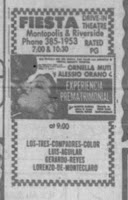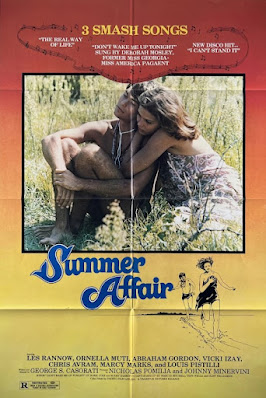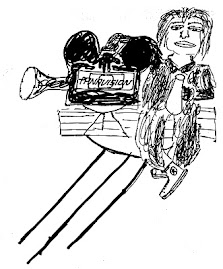“I've gotta tell you, boys, I couldn't be more excited about this...When people hear me describing it over the radio, they are going to remember that AM radio is a viable and modern source for news and entertainment.”
I do
not carry the same kind of idealistic belief in the revival of
amplitude modulation that Barry Pasternak of KNER possesses, but
as a child of the ‘70s, I have an enormous awe for the massive
power it once carried over the nation. It helped that I grew up in
Cincinnati, the home of “The Big One” WLW, still 50,000 watts
strong 24/7, and the place where Ruth Lyons, Rod Serling, and Jean
Shepherd made their bones. I heard lots of stories from my father of
listening to his favorite programs in his childhood. The classic Looney Tunes cartoons I watched on television were constantly referencing the
stars of the medium for jokes. And in my middle school years, I even
had an Old Time Radio phase, vainly proselytizing to my peers about
the aural joys of “SUSPENSE,” “LIGHTS OUT!,” and the Lucky
Strike Hour. I think this ad campaign in the catalog mailings I
received should have been a big warning about that folly:
"We need some fun marketing: what's our demographic?"
"Never-married men over 40 with fiveheads who actually think amassing a library of these tapes will make them interesting."
“That’s quite the polycule.”
In my defense however, amid the larger culture of the ‘70s, Old Time Radio was getting a significant celebration, arguably its last. In late November 1976, NBC marked its 50th Anniversary of existence with a four and a half hour “THE BIG EVENT” special called “THE FIRST FIFTY YEARS,” covering its evolution from radio to television programming, with a cross-section of its famous personalities past and present, and narration by Orson Welles. The reception and ratings were strong enough to lead to two more similar anniversary programs, again narrated by Welles. Not to be outdone, when CBS marked its own 50th Anniversary in September 1977, their radio affiliates aired a three-hour celebration, broken into six self-contained half-hour episodes. And six months later, when their television division hit 50, CBS aired a mammoth seven-night, 9.5 hour retrospective, “CBS ON THE AIR,” which opened with its beginnings as the first radio rival to NBC. And George Lucas, riding high off of STAR WARS, had announced his next intended directorial project would be a comedy about the OTR era called RADIOLAND MURDERS (though it would take another 15 years to finally happen with him shifting to producing).
Concurrently, a ‘50s culture renaissance, ostensibly initiated by Mr. Lucas’ AMERICAN GRAFFITI in 1973, but traceable all the way to 1968, was also holding the public interest longer than most trends. GREASE was a Broadway sensation and quickly optioned for film, “HAPPY DAYS” was a consistent television favorite, Richard Nader’s “Rock’n’Roll Revival” concert tours were selling out venues, and AM radio was happily blending the classics of the era with the new Top 40 hits of the day. Eventually, the cleaner sound and tighter formatting of FM radio would contribute to AM stations all but abandoning entertainment and music programming in favor of news and political talk formats. But for a while, it wouldn’t be uncommon for me to, say, turn on 55 WKRC, hear a classic Coasters track like “Charlie Brown,” and maybe half an hour later, hear Bad Company’s cover of the Coasters’ “Young Blood” in the same DJ shift.
It is within this climate that two modest films, both underwritten by Paramount, and both personal favorites of mine, were produced. And there are an uncanny amount of unintentional parallels and serendipitous connections between them, especially when watched in a double feature. Which can be difficult, because unfortunately, each film also has some accessibility issues for the average home viewer.
On Friday, October 31, 1975, ABC aired the World Premiere of an original made-for-television feature, THE NIGHT THAT PANICKED AMERICA, a semi-fictional portrayal of Orson Welles and his game-changing October 30, 1938 Mercury Theatre of the Air broadcast of H.G. Wells’ WAR OF THE WORLDS, and its repercussions on a cross-section of the audience who believed the wild depictions of Martians on Earth to be a very real threat. Anthony Wilson and Nicholas Meyer’s screenplay integrates the actual broadcast script written by Howard Koch, interspersed with speculative story threads about the spectrum of reactions, comical to near-tragic, based on press accounts of the day, though modern historians have disputed the coverage, suggesting these incidents were misrepresented by newspapers who saw radio as an upstart to their business and sought to discredit the medium. Director Joseph Sargent had earlier directed the 1974 hijack thriller masterpiece THE TAKING OF PELHAM ONE TWO THREE, and again, on a smaller scale, juggles the multiple narratives nimbly, adding his own thoughtful (and uncredited) narration to the top and bottom of the film.
The Halloween night broadcast of NIGHT proved to be a surprise success, ranked 18 in the weekly Nielsen Top 20, with a 21.1 rating and a 38 share. (By comparison, its lead-in, the TV series “BARBARY COAST,” was among the Bottom 10 in 65th place with a 9.6 rating and a 17.0 share) It was eligible for three Emmy Awards as a Special Program - Drama or Comedy - Original Teleplay, nominated for Outstanding Writing and Outstanding Film Editing, and winning Outstanding Film Sound Editing. It also won both the Golden Nymph Grand Prix for Best Single Program entry and the Silver Nymph for Best Drama at the International Television Festival in Monte Carlo, a distinction no American television production had won since 1968; the award was announced by Prince Rainier and Princess Grace of Monaco. Newspaper critics particularly hailed Paul Shenar, then mostly known for stage work and some TV guest-star appearances, for his performance as Orson Welles, a uniquely challenging role since he was legally limited to speak only the actual dialogue Welles delivered in the original program. (Sargent had met with Welles to enlist his participation, but other obligations intervened.) A limited-run DVD-R edition was released as an Amazon exclusive in 2014, and as of this writing, only the Flix-Fling platform offers it for on-demand viewing.
Two and a half years later, on March 17, 1978, AMERICAN HOT WAX was released in theatres, a semi-fictional portrayal of Alan Freed and his game-changing broadcasts of rock and roll music in the late ‘50s, and its repercussions on a cross-section of the audience who believed the wild rhythms and lyrics to be a very real threat. The screenplay by author/playwright John Kaye streamlines several years of incidents in Freed’s history into a week’s timeline, and takes some outright liberties as well - “Teenage Louise,” the story’s Carole King avatar, claims to have written songs that were hits years before the September 1959 setting – but, to borrow the words of Tim Lucas in his January 1992 Video Watchdog review of Oliver Stone’s THE DOORS, it “addresses [his] life as a work of metaphorical biography, in which individual scenes may not be absolutely true to fact or chronology, but remain sedulously true to the chronology of the subject’s own times and emotions...in other words, the truth unencumbered by facts.” Floyd Mutrux’s direction alternates quiet individual reflection with accelerating group immersion, assisted by D.P. William Fraker’s use of up to eight cameras to cover the climactic concert. Though producers certainly would have wanted to draw the boomers who lived through these events, for this writer, the filmmakers’ intent was and is to convey to new generations, living in the wake of what rock wrought while listening to its derivatives, how it felt to be experiencing the movement for the first time. The poster tagline is not “Remember the good old days,” attempting to sell nostalgia; it is “You should’ve been there,” declaring that viewers will be thrust into the living moment.
Despite being beloved by Michael Eisner, who reportedly watched it 12 times, AMERICAN HOT WAX did not draw well in its 600 screen nationwide release, grossing only $9 million in its initial five weeks in the marketplace. “Top 10”-style box office reporting was not yet a widely popular or accessible public news priority, so specific ranking is not readily found, but seeing as its competition included the recently opened THE FURY and COMA, along with the extremely durable CLOSE ENCOUNTERS, THE GOODBYE GIRL, SATURDAY NIGHT FEVER...and STAR WARS...it’s not surprising that it got lost in the crowd. Most print reviews accused it of hagiography and nitpicked its historical accuracy and its use of L.A. locations for a New York story. In contrast, rock critic Greil Marcus declared, “the film may have jumbled the facts, but it’s the most emotionally accurate movie about rock ‘n’ roll ever made...[with] a brooding, beautifully underplayed performance by Tim McIntire as Freed, this was the finest movie of any kind I saw this year.” Aside from a sublicense to Fotomat for their national videocassette rental operation, and a release in the RCA Capacitance Electronic Disc format, it has not received any further home video release, and is currently not available to stream legally.
So here are two period dramas made by Paramount, based on real events but with wholly fictional story elements, centered on radio, taking place in New York City, but for budgetary purposes, filmed in Los Angeles. Each in their own fashion presenting a sort of “Great Man” narrative about their protagonists, as they individually reign calm and contentedly before a ribbon microphone. There’s even scenes where they each directly rebel against their bosses – Welles, forbidden to namecheck President Roosevelt in his script, decides that the Secretary of the Interior talks exactly like the President, while Freed’s first order of business is to play his supervisor’s number one “Do Not Play” single. Naturally, the actors themselves playing these figures had voices so rich, they were often hired to provide them for narrations, commercials, animated films, and other offscreen performances. Sadly, these actors also died much too young: Tim McIntire died from congestive heart failure at 41 on April 15, 1986, while Paul Shenar succumbed to AIDS at 53 on October 11, 1989. And for those who can’t resist “Lincoln had a secretary named Kennedy” tales, Tim McIntire was widely rumored by many, including Floyd Mutrux himself, to be the unacknowledged son of Orson Welles, so in a sense the former film presents the “imposter” Welles, followed by the “real” progeny in the latter.
But what really makes these two films siblings from a different sire are how they touch on the relative newness of radio as a medium for the masses, and how the older established forces of government and print journalism treat it and its products as a threat.
While NIGHT remains confined to the evening of the Welles broadcast, the sudden scrum of police and reporters racing into the CBS studio upon its finish hints at the fallout to come. As documented by Jefferson Pooley andMichael J. Socolow for Slate, “the papers seized the opportunity presented by Welles’ program to discredit radio as a source of news. The newspaper industry sensationalized the panic to prove to advertisers, and regulators, that radio management was irresponsible and not to be trusted.” And while the real level of panic will always be up for debate, in a retrospective for his blog Musings of aMiddle-Aged Geek, Sebastian S. writes, “Watching THE NIGHT THAT PANICKED AMERICA today, in our terrifying ‘post-truth’ era, where private citizens have raided pizzerias based on deliberately false information about baby-smuggling rings, it seems we’ve learned absolutely nothing about the incredible power and sway of electronic media since 1938, whether it’s radio, television, or the internet. [The] movie arguably holds a lot more value as a cautionary tale today than it did in 1975.”
Meanwhile in HOT WAX, forces of the state, in the roles of a District Attorney, detectives, and Internal Revenue agents, react with horror to the themes and possibilities that rock and roll music offer: sexual liberation, race-mixing, rebellion against authority. Openly racist terminology as “jungle instincts” and “spook music” casually drip out of their mouths. But they can’t, say, arrest singers, or record company executives – they’re engaging in free enterprise. The only parties they can see being successfully throttled are disc jockeys like Alan Freed, on the premise that if radio didn’t make rock popular, its influence would diminish. After all, when so many years of safe unoffensive ditties by respectable WASP performers dominated the air without incident, why, it must be crime that brought this disrputive force to power, harumph. And it is that reductive belief that fuels the one weapon they do possess to threaten him; his willingness to accept reimbursement from record labels for playing their singles without public disclosure of the exchange. And in a crucial scene, Freed refuses to officially deny that he’s culpable – his rebuttal is that any other d.j. who says they haven’t is lying. Critics of the time said the movie was giving Freed a pass for engaging in payola, but it seems more logical that he knows he’s in the crosshairs either way, and better he own his transgression than lie and be caught anyway. Maybe the real topic of discussion should be whether the law was only being enforced in this moment because black artists and businesses were benefiting from radio exposure that had to be obtained through a back channel. At story’s end, yes, Freed loses his platform and influence, but a thousand other d.j.’s keep playing the music. Oh, and payola continues on: the participants just find better ways to conceal it.
But lest the conversation get too dark, these movies also share the exhilaration of a whole mess of people in a studio either contributing to making magic happen, or merely bearing witness to it. As the Mercury Players in NIGHT create audio illusions through opening jars inside toilets and feeding noises through whistles and cones, and the actors switch voices and dialects on the flip of a finger, they are totally serious about their job, but the joy in bringing a scary story to life is palpable on their faces. While in a bravura HOT WAX sequence, a frustrated producer asks Freed to help direct a song recording, and Freed brings his traveling feast of friends, fans, and random bystanders into the room as well, and somehow, “Come Go With Me” emerges, with the cramped multitude reacting as ecstatic as if the Holy Ghost had joined them for Pentecost and brought chips.
As a sidebar for levity, I am amused at how comedian Dickie Goodman, the inventor of the “break-in” novelty record, serves as an unofficial spiritual bridge between these two films. His first hit single, under the name Buchanan and Goodman, was “The Flying Saucer Parts 1 & 2,” presenting WAR OF THE WORLDS as a rogue alien aircheck. And while Communism is one of the few vices not being blamed on rock music by the villians in HOT WAX, I don’t think it’s an accident that in “Russian Bandstand,” Goodman’s followup track with Mickey Shorr (credited to Spencer and Spencer), the ostensible #1 song in Russia sounds an awful lot like Chuck Berry’s “Maybelline” played backwards.
And then, there’s the visual component. I don’t have the means to create a proper video mashup, and I don’t have an ace editor on retainer...yet...so, for this section, just like radio, we’ll be projecting in the theatre of the mind. So fire up a simultini, sit back, relax, and watch the pictures, now, as they fly through the air…





 "And America listened to the distant thunder brought by this medium, wanting desperately to believe that they were secure from the lightning that was to come."
"And America listened to the distant thunder brought by this medium, wanting desperately to believe that they were secure from the lightning that was to come."
 "A police spokesman has said that these rock and roll enthusiasts have been behaving relatively calmly. But one wonders [what] will be aroused when the doors are closed...the lights go down...and the caterwauling begins."
"A police spokesman has said that these rock and roll enthusiasts have been behaving relatively calmly. But one wonders [what] will be aroused when the doors are closed...the lights go down...and the caterwauling begins."



































































